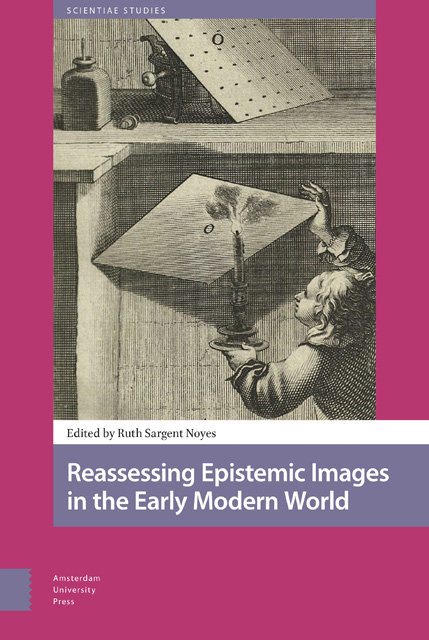Refine search
Actions for selected content:
3430 results in Popular science

Reassessing Epistemic Images in the Early Modern World
-
- Published by:
- Amsterdam University Press
- Published online:
- 15 June 2023
- Print publication:
- 22 December 2022
-
- Book
- Export citation
8 - On Probability
- from Part II - The Oracle
-
- Book:
- Why Does Math Work … If It's Not Real?
- Published online:
- 12 April 2023
- Print publication:
- 08 June 2023, pp 102-116
-
- Chapter
- Export citation
6 - On Postulates and Axioms
- from Intermezzo
-
- Book:
- Why Does Math Work … If It's Not Real?
- Published online:
- 12 April 2023
- Print publication:
- 08 June 2023, pp 76-86
-
- Chapter
- Export citation
Part I - Rare Axioms
-
- Book:
- Why Does Math Work … If It's Not Real?
- Published online:
- 12 April 2023
- Print publication:
- 08 June 2023, pp 1-45
-
- Chapter
- Export citation
Intermezzo
-
- Book:
- Why Does Math Work … If It's Not Real?
- Published online:
- 12 April 2023
- Print publication:
- 08 June 2023, pp 46-86
-
- Chapter
- Export citation
4 - On Computer Games
- from Intermezzo
-
- Book:
- Why Does Math Work … If It's Not Real?
- Published online:
- 12 April 2023
- Print publication:
- 08 June 2023, pp 49-60
-
- Chapter
- Export citation
Part II - The Oracle
-
- Book:
- Why Does Math Work … If It's Not Real?
- Published online:
- 12 April 2023
- Print publication:
- 08 June 2023, pp 87-119
-
- Chapter
- Export citation
7 - Introducing the Oracle
- from Part II - The Oracle
-
- Book:
- Why Does Math Work … If It's Not Real?
- Published online:
- 12 April 2023
- Print publication:
- 08 June 2023, pp 89-101
-
- Chapter
- Export citation
2 - On Classical Mathematics
- from Part I - Rare Axioms
-
- Book:
- Why Does Math Work … If It's Not Real?
- Published online:
- 12 April 2023
- Print publication:
- 08 June 2023, pp 15-33
-
- Chapter
- Export citation
Acknowledgments
-
- Book:
- Why Does Math Work … If It's Not Real?
- Published online:
- 12 April 2023
- Print publication:
- 08 June 2023, pp xi-xii
-
- Chapter
- Export citation
Recommended Reading
-
- Book:
- Why Does Math Work … If It's Not Real?
- Published online:
- 12 April 2023
- Print publication:
- 08 June 2023, pp 145-150
-
- Chapter
- Export citation
The Oracle, Its Majesty
- from Part II - The Oracle
-
- Book:
- Why Does Math Work … If It's Not Real?
- Published online:
- 12 April 2023
- Print publication:
- 08 June 2023, pp 117-119
-
- Chapter
- Export citation
Appendices
-
- Book:
- Why Does Math Work … If It's Not Real?
- Published online:
- 12 April 2023
- Print publication:
- 08 June 2023, pp 135-144
-
- Chapter
- Export citation
Contents
-
- Book:
- Why Does Math Work … If It's Not Real?
- Published online:
- 12 April 2023
- Print publication:
- 08 June 2023, pp vii-viii
-
- Chapter
- Export citation
5 - On Mathematical Logic
- from Intermezzo
-
- Book:
- Why Does Math Work … If It's Not Real?
- Published online:
- 12 April 2023
- Print publication:
- 08 June 2023, pp 61-75
-
- Chapter
- Export citation
Index
-
- Book:
- Why Does Math Work … If It's Not Real?
- Published online:
- 12 April 2023
- Print publication:
- 08 June 2023, pp 151-153
-
- Chapter
- Export citation
Copyright page
-
- Book:
- Why Does Math Work … If It's Not Real?
- Published online:
- 12 April 2023
- Print publication:
- 08 June 2023, pp iv-iv
-
- Chapter
- Export citation
Epilogue: The Eternal Blueprint
-
- Book:
- Why Does Math Work … If It's Not Real?
- Published online:
- 12 April 2023
- Print publication:
- 08 June 2023, pp 120-122
-
- Chapter
- Export citation
1 - Introducing the Mystery
- from Part I - Rare Axioms
-
- Book:
- Why Does Math Work … If It's Not Real?
- Published online:
- 12 April 2023
- Print publication:
- 08 June 2023, pp 3-14
-
- Chapter
- Export citation
Preface
-
- Book:
- Why Does Math Work … If It's Not Real?
- Published online:
- 12 April 2023
- Print publication:
- 08 June 2023, pp ix-x
-
- Chapter
- Export citation
